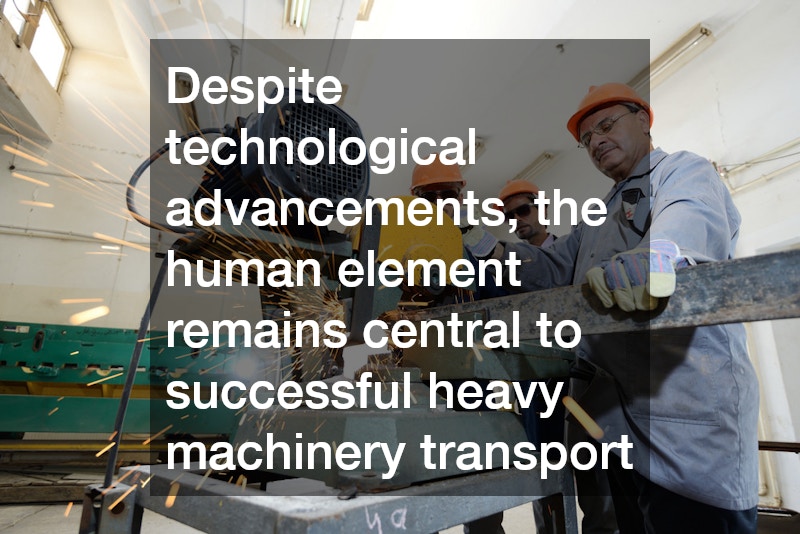Transporting heavy machinery requires a lot more than just loading and moving equipment from point A to point B. It involves meticulous planning, appropriate equipment, and skilled professionals to ensure a safe and successful delivery. Given the complexity and size of these types of cargo, neglecting any step can lead to significant challenges and costs. Understanding the intricacies of heavy machinery transport is crucial for businesses looking to avoid downtime, reduce risks, and adhere to regulatory requirements.
Understanding Different Types of Transport Equipment
The type of transport equipment used depends largely on the size, weight, and configuration of the machinery being moved. Heavy machinery transport often utilizes flatbeds, lowboys, or step-deck trailers, each suitable for specific types of loads.
For instance, lowboy trailers are often used for hauling oversized equipment such as bulldozers and excavators because they offer a lower height profile. Choosing the correct trailer ensures stability, safety, and compliance with transportation regulations. Utilizing the wrong type of trailer can lead to overhangs and clearance issues, potentially causing accidents or fines.
When considering the appropriate transport option, weight capacity is a critical factor. Not all trailers can handle the maximum weight of all machinery, which makes understanding weight limits essential. Properly distributed load weight is imperative to prevent tipping or engine strain during transportation. The vehicle’s gross vehicle weight rating (GVWR) informs decisions regarding potential transport routes and equipment needs. Knowing these parameters helps avoid potential legal penalties and ensures the machinery arrives in optimal condition.
Each piece of transport equipment offers different features that cater to various types of machinery. In addition to flatbeds and lowboys, extendable trailers might be used for especially long cargos such as cranes or wind turbine parts. Innovative methods, including multi-axle trailers, are employed to distribute the load across more axles, alleviating pressure on each section of the trailer. Many modern transport trailers are also equipped with hydraulic systems to assist with loading and unloading, making the process more seamless and safe. Investing in the right transport logistics can prevent logistical nightmares and improve operational efficiency.
Navigating Legal and Safety Regulations
Compliance with legal and safety regulations is mandatory when conducting heavy machinery transport. Each state or region may have its own set of guidelines, regarding the permitted dimensions, weight limits, and route restrictions for oversized loads. Companies need to ensure they have the necessary permits prior to transportation to accommodate these differences. Ignorance of legal requirements can result in hefty fines or delays, affecting project timelines and budgets. Therefore, detailed research and coordination with local transport authorities are imperative.
Safety cannot be compromised in heavy machinery transport, as overlooking any aspect can result in accidents or equipment damage. Adequate securing of machinery through the use of chains, ropes, or load binders is crucial to mitigate the risk of shifting loads during transit. Transport operators must be experienced and familiar with safety measures, including the use of escort vehicles and adherence to road safety standards. Regular maintenance and checks on the transporting vehicle is another layer of precaution. These practices ensure that equipment reaches its destination without incident.
Failure to adhere to stipulated safety regulations can lead to transport delays, costly repairs, or in the worst-case scenario, legal action. To avoid these pitfalls, companies should engage experienced and reputable transport services familiar with all the legal intricacies. Comprehensive insurance coverage is also a smart consideration, providing a financial safety net in the event of mishaps. Adequate preparation and professionals skilled in occupational safety standards significantly reduce transportation risks. Prioritizing both lawfulness and safety yields the best outcomes in the heavy machinery transport sector.
Efficient Planning and Execution
The success of heavy machinery transport relies heavily on strategic planning and precise execution. A critical component of this process is route planning, which involves mapping out the most feasible path that accommodates oversized loads without hindrances. Potential obstacles like low bridges, narrow roads, and construction zones must be identified and avoided to prevent delays. Working closely with logistics experts ensures all aspects of the journey are accounted for, from departure to arrival. Efficient planning not only saves time but also reduces costs associated with unnecessary detours and downtime.
Collaboration with certified transport professionals can prove invaluable, especially when dealing with complex machinery requirements. These experts bring to the table years of experience and can offer valuable insights into the nuanced challenges of heavy machinery transport. Leveraging their expertise helps streamline operations and addresses potential issues proactively. Effective communication between the logistics team, driver, and client is critical for timely updates and seamless coordination. This collaborative approach optimizes the transport process, ensuring machinery is where it needs to be, when it needs to be there.
Despite technological advancements, the human element remains central to successful heavy machinery transport. Decision-making, adaptive thinking, and responsive actions by skilled professionals ensure the mission’s success. Digital tools and tracking technologies play supportive roles, offering real-time data and insights to enhance planning accuracy. However, nothing substitutes the trained eyes and seasoned judgment of transport experts. Combining traditional service excellence with modern innovations yields the most efficient transport outcomes.
.

